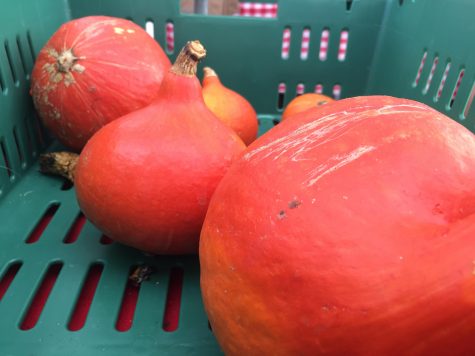Fall seasonal produce: A guide
October 11, 2016
Autumn is here, the leaves are falling and the wind is blowing. As the weather changes, so does the seasonal produce. At the farmers market, squashes and apples begin to appear, while berries and peaches disappear. The best fall produce includes beets, winter squash, persimmons, and figs, allowing for a variety of recipes this season.
Persimmons
 Ria Gupta
Ria Gupta
Bright orange and crisp, persimmons make for a great snack in the fall. The two most prominent types of persimmons include Hachiyas and Fuyus. Hachiyas, only eaten ripe, have an acorn-like shape. Fuyus resemble tomatoes, except for their bright orange color. This fruit tastes best when eaten raw, but they can also be added to baked goods. Most people eat ripe Hachiyas like pudding, using a spoon to scoop out its interior. Fuyus can be cut unpeeled and added to salads. Make sure you allow the Hachiyas to sit out on the counter for a little while, but the Fuyus should be refrigerated to keep it crisp.
Beets
 Anika RajamaniWhen buying beets, look for the ones heavy for their size. For beets with their leaves attached, check for a vibrant green, avoiding wilted and yellow leaves. The greens can be sauteed and used to make a delicious salad. Their versatility makes for a wonderful ingredient in the kitchen. Try tossing some roasted beets in your next salad or even using some to make naturally colored red velvet cupcakes. Their bright red interior flawlessly takes the place of red food coloring.
Anika RajamaniWhen buying beets, look for the ones heavy for their size. For beets with their leaves attached, check for a vibrant green, avoiding wilted and yellow leaves. The greens can be sauteed and used to make a delicious salad. Their versatility makes for a wonderful ingredient in the kitchen. Try tossing some roasted beets in your next salad or even using some to make naturally colored red velvet cupcakes. Their bright red interior flawlessly takes the place of red food coloring.
Winter Squash
 Anika Rajamani
Anika Rajamani
If you are looking for the perfect addition to a soup, look no further! Winter squash can be bought year-round, but they really thrive in the summer and the fall. The term winter squash encompasses many different varieties of squash. Each type of squash has its own special texture and taste which allow it to be cooked in different ways. When in the store, make sure to choose hard squashes that do not cave in when pressed. The color of the squash should be bright, and the skin should not peel easily. If you are going to prepare the squash whole, you should make sure to really give it a good scrub. For other recipes, you can just remove the outer layer with a sharp knife, cut the squash in half, and remove all the seeds.
This piece was originally published in the pages of The Winged Post on October 11, 2016.


















![“[Building nerf blasters] became this outlet of creativity for me that hasn't been matched by anything else. The process [of] making a build complete to your desire is such a painstakingly difficult process, but I've had to learn from [the skills needed from] soldering to proper painting. There's so many different options for everything, if you think about it, it exists. The best part is [that] if it doesn't exist, you can build it yourself," Ishaan Parate said.](https://harkeraquila.com/wp-content/uploads/2022/08/DSC_8149-900x604.jpg)




![“When I came into high school, I was ready to be a follower. But DECA was a game changer for me. It helped me overcome my fear of public speaking, and it's played such a major role in who I've become today. To be able to successfully lead a chapter of 150 students, an officer team and be one of the upperclassmen I once really admired is something I'm [really] proud of,” Anvitha Tummala ('21) said.](https://harkeraquila.com/wp-content/uploads/2021/07/Screen-Shot-2021-07-25-at-9.50.05-AM-900x594.png)







![“I think getting up in the morning and having a sense of purpose [is exciting]. I think without a certain amount of drive, life is kind of obsolete and mundane, and I think having that every single day is what makes each day unique and kind of makes life exciting,” Neymika Jain (12) said.](https://harkeraquila.com/wp-content/uploads/2017/06/Screen-Shot-2017-06-03-at-4.54.16-PM.png)








![“My slogan is ‘slow feet, don’t eat, and I’m hungry.’ You need to run fast to get where you are–you aren't going to get those championships if you aren't fast,” Angel Cervantes (12) said. “I want to do well in school on my tests and in track and win championships for my team. I live by that, [and] I can do that anywhere: in the classroom or on the field.”](https://harkeraquila.com/wp-content/uploads/2018/06/DSC5146-900x601.jpg)
![“[Volleyball has] taught me how to fall correctly, and another thing it taught is that you don’t have to be the best at something to be good at it. If you just hit the ball in a smart way, then it still scores points and you’re good at it. You could be a background player and still make a much bigger impact on the team than you would think,” Anya Gert (’20) said.](https://harkeraquila.com/wp-content/uploads/2020/06/AnnaGert_JinTuan_HoHPhotoEdited-600x900.jpeg)

![“I'm not nearly there yet, but [my confidence has] definitely been getting better since I was pretty shy and timid coming into Harker my freshman year. I know that there's a lot of people that are really confident in what they do, and I really admire them. Everyone's so driven and that has really pushed me to kind of try to find my own place in high school and be more confident,” Alyssa Huang (’20) said.](https://harkeraquila.com/wp-content/uploads/2020/06/AlyssaHuang_EmilyChen_HoHPhoto-900x749.jpeg)











